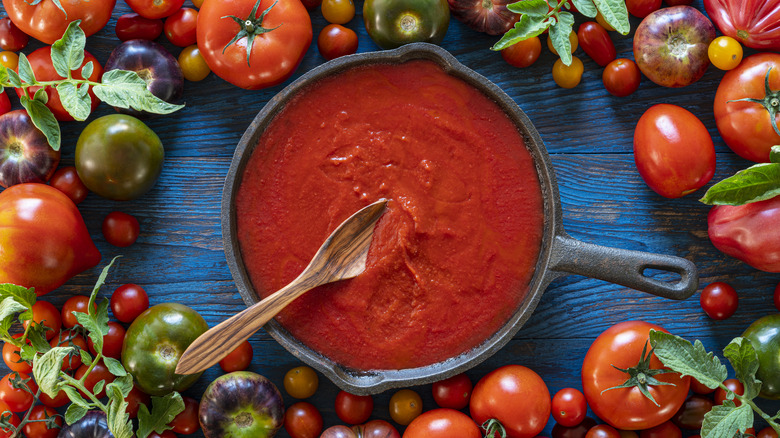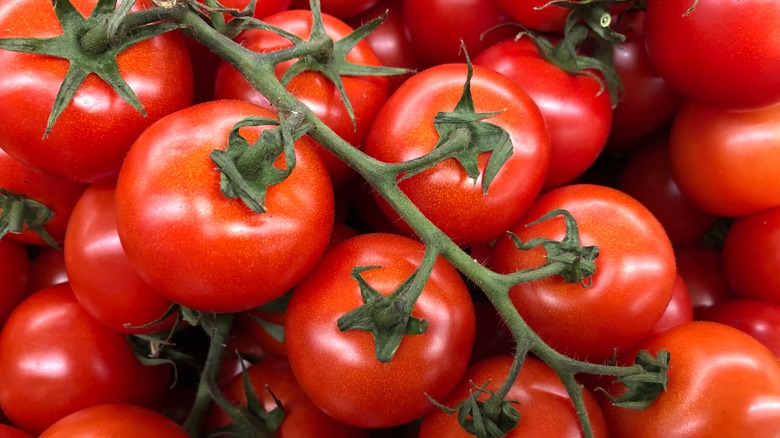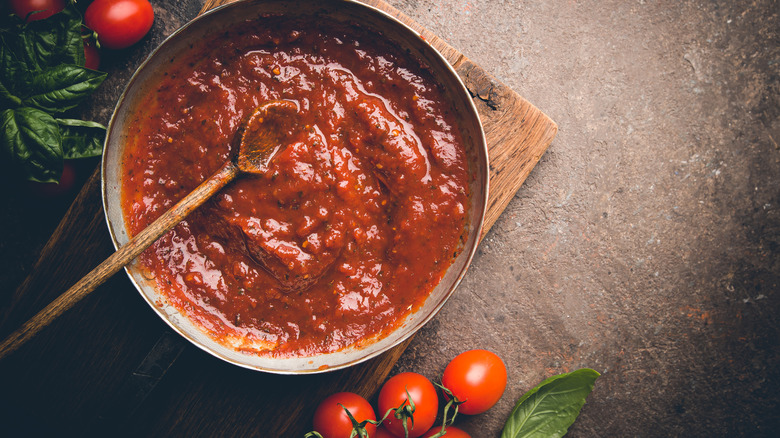Don't Ignore The Vine When Making Fresh Tomato Sauce
Whether you're making a homemade pizza — dough and all — or the perfect plate of pasta from scratch, fresh tomato sauce is essential. Without a doubt, the best tomato sauce recipe features an aromatic blend of ingredients like olive oil, basil, garlic, and, of course, ripe tomatoes. But, when it comes to creating the flavorsome Italian classic, there's one element of a tomato that shouldn't be ignored: the vine.
Skip the canned varieties and make a mouthwatering tomato sauce at home using this secret ingredient. Incorporating the tender, green vine into your savory pot of red sauce is a great way to make use of every bit of the juicy fruit. But, using the stem isn't just a low-waste, sustainable cooking hack that's become popular on social media. It can also take the flavor profile of your sauce up a notch, adding a delicious dimension to your hearty spaghetti, cheesy baked ziti, creamy eggplant casserole, and much more.
The vine adds enhanced flavor
Depending on the variety, juicy red tomatoes typically carry a sweet or tangy kick with every bite due to the balance of sugars and acids contained within them. Similarly, the vine they grow on features a rich, tomato-y taste that — when cooked into a sauce — releases oils and imparts a sapid, herby flavor for a delicious added depth.
Incorporating the fragrant ingredient into your sauce is easy and only requires a few added steps when making your chosen recipe. Simply give the vines a good rinse (as you would with the tomatoes), tie them up using a piece of cooking twine for easy removal, and then toss the bundle in with the tomatoes and the other sauce ingredients and let it simmer. Just remember to remove the leaf bundle before mashing or blending the cooked tomatoes.
One more tip: Don't go tossing the tomato leaves either. In true low-waste form, this oft-discarded part of the plant is also exceptionally useful in the kitchen.
Make use of tomato leaves, too
Contrary to popular belief, you can eat tomato leaves. And, just like the vines, they carry a lot of flavor, too. When simmering tomato sauce, just add in a few leaves as you would with basil, acting as a palate enhancer. Or, throw the leaves into a batch of soup or stew for a satisfying aroma.
Similar to the roots and stems, the leaves of tomatoes do, however, contain poisonous alkaloids like tomatine and solanine, similar to other nightshade counterparts. These organic compounds are a natural way to help plants ward off predators. However, studies show they are only toxic to humans when consumed in very large doses (such as a pound or more). If you're concerned about levels of toxicity, you can always place the leaves into a cloth cooking bag before tossing into a saucepan so they can be easily removed with a suggested ratio of ¼ cup of minced leaves per 8 cups of sauce.
Feeling inspired yet? The next time you're at the farmer's market, be sure to load up on the essentials: tantalizing tomatoes — fruit, leaves, vine, and all.



